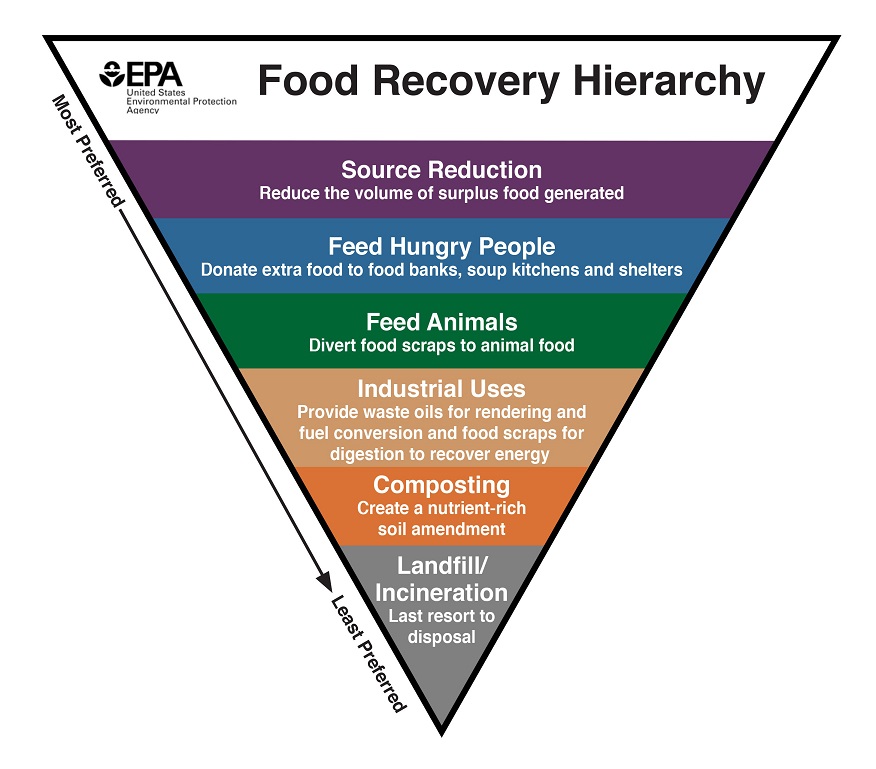Our Services > Sustainability Programs > Climate Action > Education and Outreach > Tips to Reduce Food Waste > Tips to Reduce Food Waste
Tips to Reduce Food Waste
Did you know food production, transportation, and handling of food generate significant carbon dioxide (CO2) emissions? When food ends up in landfills, it generates methane, an even more potent greenhouse gas.
Wasted food is one of largest generators of greenhouse gas (GHG) emissions globally. 30-40% of food is wasted each year, and 43% of that food waste occurs at the household level.
The Town of North Hempstead aims to provide strategies, local resources and inspirational work happening in the Town to reduce food waste. Our plan uses the US EPA Food recovery Hierarchy to prioritize solutions: #1 Prevent, #2 Donate, #3 Divert.

#1 PREVENTION
Here are some great tips to reduce your volume of surplus food:
Smart Shopping
- Take an inventory of the food in the house so you don’t buy what you already have.
- Make a meal menu for the week.
- Make a list and stick to it.
- Buy fresh items in smaller quantities.
- Resist impulse buys by shopping on a full stomach.
- Shop at farmers markets. Local produce is likely to stay fresh longer since it was picked more recently than supermarket produce.
- Intentionally purchase imperfect produce that might otherwise be discarded.
Smart Storage
- “FIFO” stands for “first in, first out” and is a useful way to organize food at home.
- Invest in quality food containers that do not leak and are light and convenient to carry.
- Keep your refrigerator below 41°F.
- Store cooked foods on shelves above raw foods.
- Some fruits give off natural gases that make nearby foods spoil faster. Store apples, bananas, and tomatoes apart from other perishables to help keep them fresh longer.
- Writing down types of foods that go bad can help identify the foods to cut back on.
- Freezing foods can help preserve them for later use. Divide food into individual portions that can be defrosted separately.
- Do not overfill your fridge and freezer. Leave enough space so cold air can circulate.
Think twice before throwing food away
- Many greens and vegetables may slightly soften or wilt when they are just past ripe. They still may make excellent additions to soups, smoothies, or baked dishes.
- Manufacturers put different labels on foods, such as “sell by” or “use by.” The Food and Drug Administration (FDA) estimates that up to 20% of food waste comes from the confusion over these dates. The easiest way to identify bad foods is to trust your senses. For dairy products check for an off color, mold, or a sour smell. If produce still appears fresh and usable, it is usually fine to eat it.
- Choose 1 or 2 days each week to eat any leftovers you may have stored in the fridge or freezer.
- Properly canning or pickling foods can help to extend their shelf life. Examples include turning apples into applesauce or cucumbers into pickles.
- Use leftover vegetable scraps to make a soup stock.
- Tips for Using Bread
- Refresh stale bread by placing it in a dampened paper bag and baking in a 300°F oven for 3 minutes.
- Day old bread can be used in many recipes like French toast, bruschetta, bread pudding, stuffing, meatloaf, and can also be made into breadcrumbs, croutons and used to thicken soup.
- You can freeze bread in a zip lock bag and eat it later.
- Place stale bread in the crisper drawer in your refrigerator to absorb moisture and keep vegetables fresh. Replace every couple of days.
Restaurant eating
- Ask for a meal that does not contain ingredients you will not eat.
- Ask for smaller portions.
- Share meals.
- Bring home (and eat!) your leftovers.
- Give your leftovers to someone in need.
- Try a tapas or small plates restaurant.
- Support restaurants with good sustainability practices.
- If eating at a buffet, watch your portions. Buffet diners with large plates waste 135% more food than those with smaller ones.
#2 DONATE
Many people in our community face food insecurity. Consider giving unwanted food to those in need.
Click here for a list of local food pantries/ food banks that accept donations. Make sure to contact them ahead of drop off for instructions.
#3 DIVERT
Composting helps divert food from landfills by letting organic matter decompose and then reusing it as fertilizer. Here are some strategies to get started…
- Compost at home! North Hempstead residents can purchase a tumbler compost bin for a reduced fee. Learn more at https://www.northhempsteadny.gov/sustainability
- The Long Island Science Museum in Port Washington has a Community Compost pile run by a local nonprofit Transition Town. They have collected 7,000 pounds of food waste since 2020. Learn more at www.transitiontownpw.org
Resources
https://sustainableamerica.org/resources
https://stopfoodwaste.org/tips